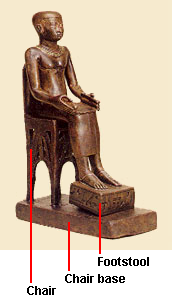
XPS MultiQuant |
Application Examples |


The Egyptian Collection of the Museum of Fine Arts in Budapest has a small statue of Imhotep. Imhotep was an Egyptian scientist (later he was respected as a god), he built the first pyramid for pharaoh Djoser in Saqqara.
It was reasonable assumed that various parts of the statuette were made of different alloys thus samples from of several parts were analysed. The quantity of the available samples was limited and it had to be preserved for other investigations as well.
The chart shows the metallic composition of the different samples while other elements (oxygen, carbon, etc.) are omitted. One the basis of the analyses, the samples can be categorised in two groups: lead containing (footstool) and lead free (chair, chairbase) alloys.

Bronze alloys are categorised by the tin and lead content in the literature. By the quantitative analysis the materials of the statuette can be assigned as “tin-bronze with high tin content” and “lead-tin-bronze with low lead content”. The questions whether the various parts of the statuette originally belonged together or nor, whether they come from the same workshop or not, and what are the conclusions on age determination cannot be fully answered. Chemical composition data are available only for a limited number of accurately dated bronze objects. In any case, our results still contribute to the clarification of the genetics of the bronze statuette.
M. Tóth, I. Bertóti, M. Mohai, I. Fórizs, I. Vozil:
Material Analysis of the Bronze Statuette of Imhotep.
Bulletin du Musée Hongrois des Beaux-Arts 95, 35 (2001).